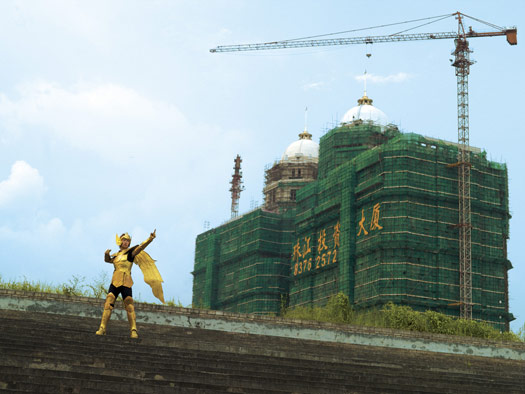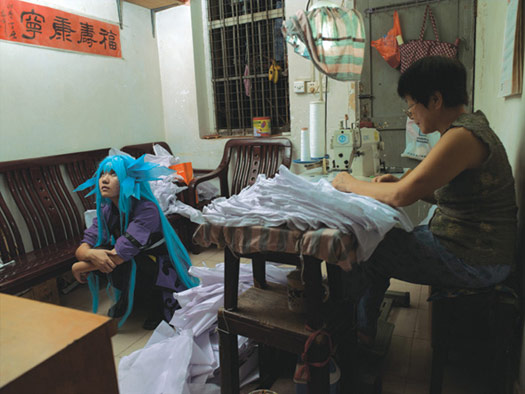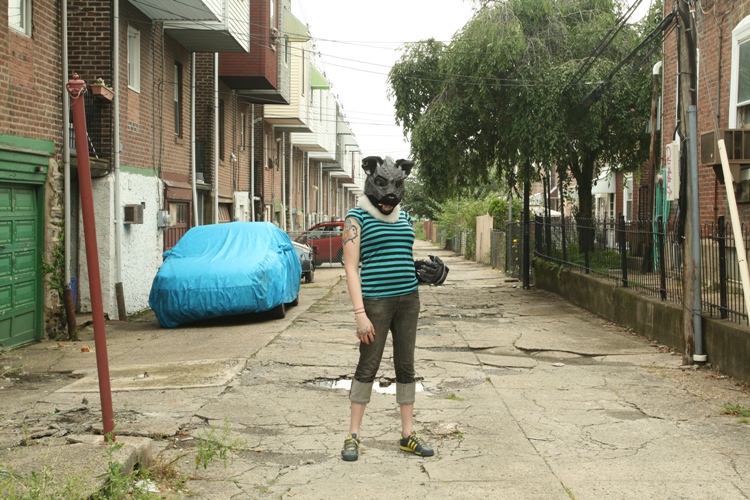I’ll let you in on a secret: I’m a bit of a cosplay fanatic. Yes, these days I sport DKNY glasses and sleek monochromatic clothing, but my urban fashionability is merely a cloak for a tremendous amount of geekery. To be fair, I don’t cosplay myself. When I was most active, I served more as the tagalong, helping with costumes and the like, and these days, I focus on photographing others, rather than participating myself.

Cao Fei, "Golden Fighter (COSPlayers Series)," 2004. © Cao Fei, courtesy the artist and Lombard-Freid Projects, New York.
But there will always be a special place in my heart for cosplay, so you’ll understand my excitement when I first stumbled upon Cao Fei’s visual work at The Thirteen: Chinese Video Now, a group exhibition at PS1 three years ago. In the video, cosplayers venture through the streets of a rapidly-growing but desolate Guangzhou, acting out epic battles while the normalcy of the city chugs along. In both her photos and videos, we see cosplayers outside the glitzy-geekery of anime and comic conventions and immersed in the context of the everyday.
The work itself is visually stunning. The contrast of the colorful costumes with the staid backdrop of the city speaks to the fantasy projected in cosplay culture, and how much that fantasy can clash with the mundanities of making a living, getting along with parents and growing up in a country that itself is coming of age in the 21st century.
The series struck a personal chord in me in particular, as it reminded me so much of my cosplaying friends. After each convention, I’d watch them shed their outfits, cram into nondescript cars, don school uniforms and work attire, argue with their parents, watch television and just generally return to a normal life. In their heads, they still wanted to live the epic lives of Tifa Lockheart and Naruto, normal life be damned, and they’d immerse themselves in anime message boards and costume-making circles in anticipation of the next big event.

Cao Fei, "Yanmy at Home (COSPlayers Series)," 2004. © Cao Fei, courtesy the artist and Lombard-Freid Projects, New York.
Does art expand our ability to imagine? Cao Fei’s series is no doubt imaginative. After my first exposure to her work, I found myself lost in her images, and I started seeing swords and fireballs coursing through the streets of Manhattan. But it’s also the imagination of her subjects that helps bring these photos to life. In their eyes is a world far removed from the anxieties of a developing China, a world where people (not always human) fly and shoot fireballs and twirl weapons effortlessly, and the fate of the universe rests in the balance. In so many ways, Cao Fei’s subjects are as much artists as the artist herself.
Perhaps it’s my bias as an artist, but engaging in art, creating art both as a response to and in imitation of others’ work is often the best way to step into an artist’s imagination, whether it be faraway surrealist dreams or sharp technical realism. Rather than passively absorb the stories told in hard-to-find DVDs of their favorite Japanese animation, cosplayers take the experience further by creating these worlds in their daily lives. They construct three dimensional costumes based on two dimensional designs and act out alternate storylines inspired by a limited series run. In other words, their imaginations come alive.

A self-imagined character cosplay in Philadelphia. Photo by An Xiao.
As we look to a generation growing up with not just glossy photo magazines but Flickr, not just brilliant newspaper op-eds but user-driven blogs, not just democratic elections but engaged political organizing via Facebook invites and Twitter blasts, I wonder if imaginative artists can’t also borrow something from the user-engaged ethic embodied by cosplay and new media.
The runaway success of Antony Gormley’s One & Other points to how this ethic is gaining traction in the world of art. In this project, he invites anyone living in the UK to occupy the Fourth Plinth in London’s Trafalgar Square, where their performance will be broadcast not just to Londoners but to all the world via a live video feed. Public performance art, once the domain of MFA graduates and Chelsea conceptualists, is democratized, hour by hour, each day, for 100 days.
Like Cao Fei and the cosplayers she works with, One & Other gives average Londoners their very own brand of YouPlinth and awakens an opportunity to take the stage, at least for an hour, and exercise their imaginations in front of an international audience. Here are thousands of arts lovers who don’t want to simply view contemporary art, nor to simply participate in it, nor to simply respond. They want to create art themselves.
Photographer and digital media artist An Xiao studies the emerging 21st century culture, as manifest in cities, nature and individuals, through the lens of eastern and western philosophy. Her social media-based projects have been featured with the Brooklyn Museum, The Guardian, ARTNews, NYFA Current and others. She founded and directs @Platea, an online public art collective. She tweets and blogs with some regularity, and her work can be found online at www.anxiaostudio.com.




Pingback: @Platea: A Global Online Public Art Collective: hopes/dreams/fears … | Welcome to Winchester
Pingback: Shots from The Warholian at Royal/T Cafe and Gallery | Digital/Analog – An Xiao Studio Blog